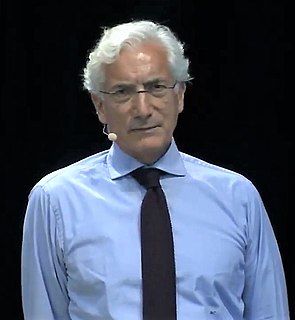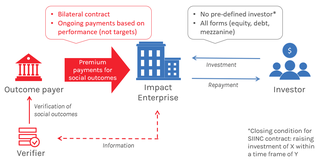
In finance, a bond is a type of security under which the issuer (debtor) owes the holder (creditor) a debt, and is obliged – depending on the terms – to repay the principal of the bond at the maturity date as well as interest over a specified amount of time. The interest is usually payable at fixed intervals: semiannual, annual, and less often at other periods. Thus, a bond is a form of loan or IOU. Bonds provide the borrower with external funds to finance long-term investments or, in the case of government bonds, to finance current expenditure.

A credit rating agency is a company that assigns credit ratings, which rate a debtor's ability to pay back debt by making timely principal and interest payments and the likelihood of default. An agency may rate the creditworthiness of issuers of debt obligations, of debt instruments, and in some cases, of the servicers of the underlying debt, but not of individual consumers.

Structured finance is a sector of finance - specifically financial law - that manages leverage and risk. Strategies may involve legal and corporate restructuring, off balance sheet accounting, or the use of financial instruments.

A collateralized debt obligation (CDO) is a type of structured asset-backed security (ABS). Originally developed as instruments for the corporate debt markets, after 2002 CDOs became vehicles for refinancing mortgage-backed securities (MBS). Like other private label securities backed by assets, a CDO can be thought of as a promise to pay investors in a prescribed sequence, based on the cash flow the CDO collects from the pool of bonds or other assets it owns. Distinctively, CDO credit risk is typically assessed based on a probability of default (PD) derived from ratings on those bonds or assets.

The bond market is a financial market where participants can issue new debt, known as the primary market, or buy and sell debt securities, known as the secondary market.This is usually in the form of bonds, but it may include notes, bills, and so on for public and private expenditures. The bond market has largely been dominated by the United States, which accounts for about 39% of the market. As of 2021, the size of the bond market is estimated to be at $119 trillion worldwide and $46 trillion for the US market, according to Securities Industry and Financial Markets Association (SIFMA).

Sir Ronald Mourad Cohen is an Egyptian-born British businessman and political figure. He is the chairman of The Portland Trust and Bridges Ventures. He has been described as "the father of British venture capital" and "the father of social investment".

Social finance is a category of financial services which aims to leverage private capital to address challenges in areas of social and environmental need. Having gained popularity in the aftermath of the 2008 Global Financial Crisis, it is notable for its public benefit focus. Mechanisms of creating shared social value are not new, however, social finance is conceptually unique as an approach to solving social problems while simultaneously creating economic value. Unlike philanthropy, which has a similar mission-motive, social finance secures its own sustainability by being profitable for investors. Capital providers lend to social enterprises who in turn, by investing borrowed funds in socially beneficial initiatives, deliver investors measurable social returns in addition to traditional financial returns on their investment.
Conservation finance is the practice of raising and managing capital to support land, water, and resource conservation. Conservation financing options vary by source from public, private, and nonprofit funders; by type from loans, to grants, to tax incentives, to market mechanisms; and by scale ranging from federal to state, national to local.
Impact investing refers to investments "made into companies, organizations, and funds with the intention to generate a measurable, beneficial social or environmental impact alongside a financial return". At its core, impact investing is about an alignment of an investor's beliefs and values with the allocation of capital to address social and/or environmental issues.
Social enterprise lending is a form of social finance which refers to the practice of offering loans and other financing vehicles below current market rates to social enterprises and other organisations pursuing social goals. This is often referred to as "patient lending," or financing with "soft" terms. Patient lending recognises that projects with social outcomes often reach profitability later than commercial projects. Softening the terms of a loan means that a social lender may offer provisions such as longer loan terms, lower interest rates and repayment "holidays" where capital and interest repayments are not due until the project is profitable. Social lenders might also offer small grants as part of an investment package.

A social impact bond, also known as pay-for-success financing, pay-for-success bond, social benefit bond or simply a social bond, is one form of outcomes-based contracting. Although there is no single agreed definition of social impact bonds, most definitions understand them as a partnership aimed at improving the social outcomes for a specific group of citizens. The term was originally coined by Geoff Mulgan, chief executive of the Young Foundation. The first SIB was launched by UK-based Social Finance Ltd. in September 2010.
Green bonds are fixed-income financial instruments (bonds) which are used to fund projects that have positive environmental and/or climate benefits. They follow the Green Bond Principles stated by the International Capital Market Association (ICMA), and the proceeds from the issuance of which are to be used for the pre-specified types of projects.
Eco-investing or green investing, is a form of socially responsible investing where investments are made in companies that support or provide environmentally friendly products and practices. These companies encourage new technologies that support the transition from carbon dependence to more sustainable alternatives. Green finance is "any structured financial activity that has been created to ensure a better environmental outcome."
The Australian government debt is the amount owed by the Australian federal government. The Australian Office of Financial Management, which is part of the Treasury Portfolio, is the agency which manages the government debt and does all the borrowing on behalf of the Australian government. Australian government borrowings are subject to limits and regulation by the Loan Council, unless the borrowing is for defence purposes or is a 'temporary' borrowing. Government debt and borrowings have national macroeconomic implications, and are also used as one of the tools available to the national government in the macroeconomic management of the national economy, enabling the government to create or dampen liquidity in financial markets, with flow on effects on the wider economy.
Big Society Capital Limited (BSC) is an independent social investment institution in the United Kingdom, which provides finance to organizations that support front-line social sector entities to help them grow.
Securitization is the financial practice of pooling various types of contractual debt such as residential mortgages, commercial mortgages, auto loans or credit card debt obligations and selling their related cash flows to third party investors as securities, which may be described as bonds, pass-through securities, or collateralized debt obligations (CDOs). Investors are repaid from the principal and interest cash flows collected from the underlying debt and redistributed through the capital structure of the new financing. Securities backed by mortgage receivables are called mortgage-backed securities (MBS), while those backed by other types of receivables are asset-backed securities (ABS).
The British Asian Trust was founded in 2007 by Charles III, then Prince of Wales, and a group of pre-eminent British Asian business leaders. The Trust works to tackle the widespread poverty and hardship in South Asia to which millions are currently subjected.
Development Impact Bonds (DIBs) are a performance-based investment instrument intended to finance development programmes in low resource countries, which are built off the model of social impact bond (SIB) model. In general, the model works the same: an investor provides upfront funding to the implementer of a program. An evaluator measures the results of the implementer's program. If these results hit a target set before the implementation period, an outcome payer agrees to provide investors a return on their capital. This ensures that investors are not simply engaging in concessionary lending. The first social impact bond was originated by Social Finance UK in 2010, supported by the Rockefeller Foundation, structured to reduce recidivism among inmates from Peterborough Prison.
Public-private partnerships are cooperative arrangements between two or more public and private sectors, typically of a long-term nature. In the United States, they mostly took the form of toll roads concessions, community post offices and urban renewal projects. In recent years, there has been interest in expanding P3s to multiple infrastructure projects, such as schools, universities, government buildings, waste and water. Reasons for expanding public-private partnership in the United States were initially cost-cutting and concerns about Public debt. In the early 2000s, P3s were implemented sporadically by different States and municipalities with little federal guidance. During Obama's second term, multiple policies were adopted to facilitate P3 projects, and Congress passed bills in that direction with overwhelming bipartisan support. My Brother's Keeper Challenge is an example of a public–private partnership. Some Private-public partnerships were carried out without incident, while others have attracted much controversy.

The Social Impact Incentives (SIINC) model is a blended finance instrument introduced for the first time in 2016. In the SIINC model, enterprises are provided with time-limited premium payments for achieving social impact, thus aligning profitability with their social impact and enabling them to attract growth capital. The SIINC agreement is a bilateral contract between an outcome funder and an enterprise; an independent verifier assesses the impact performance and clears payments for disbursement; the investment between the enterprise and its investor is arranged via a separate contract.






